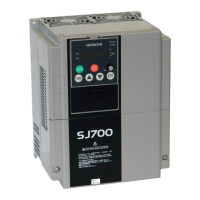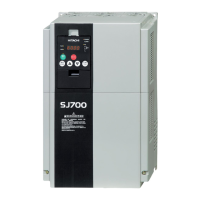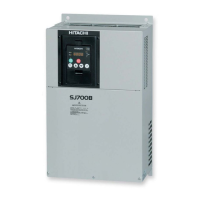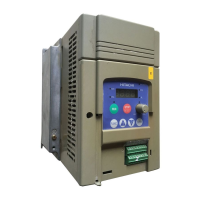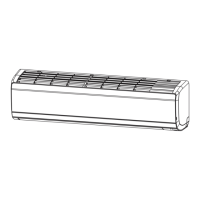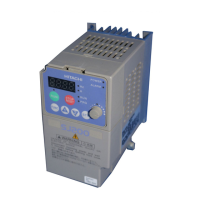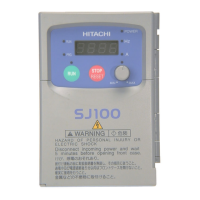Do you have a question about the Hitachi SJ700-300HFEF2 and is the answer not in the manual?
Achieves high starting torque (200% at 0.3Hz) through advanced control.
Maintains high torque (150%) even at 0Hz speed for demanding applications.
Prevents inverter trips during acceleration/deceleration with high-speed internal calculation.
Controls DC bus voltage to prevent over-voltage trips during deceleration.
Enables simple sequence operation and automatic speed control via EzSQ software.
Facilitates sequence control and automatic speed adjustment using EzSQ.
Reduces cost and space by integrating EMC filtering for noise reduction.
Reduces cost and space compared to external braking controllers.
Meets CE, UL, c-UL, C-Tick approvals for wide usability.
Micro surge suppress function, RoHS compliant, and improved environment.
Ignores brief power failures if DC bus voltage remains stable.
Provides high-quality emergency stop via direct electric circuit shutdown.
Enables restart by searching motor frequency without residual voltage.
Safely stops the motor upon power loss.
Automatically adjusts carrier frequency based on motor current.
Detailed specifications for 200V class SJ700 models including enclosure, ratings, and braking.
Detailed specifications for 400V class SJ700 models including enclosure, ratings, and braking.
Guide to configuring SJ700 models based on applicable motor, voltage, and options.
Comprehensive list of general specifications for the SJ700 series.
Details control methods, frequency ranges, V/f characteristics, and speed fluctuation.
Describes terminal functions, intelligent input/output terminals, and their assignments.
Lists displayed parameters, protective functions, environmental conditions, and options.
Shows parameter display contents and drive status monitor LEDs.
Guides on how to set the output frequency using the digital operator.
Details terminal descriptions and arrangement for main circuits.
Details terminal descriptions and arrangement for control circuits.
Lists monitoring functions and main profile parameters with their codes and settings.
Details parameters related to output frequency, acceleration, and deceleration times.
Lists standard functions like frequency source, run command, and base frequency settings.
Parameters for selecting restart modes and setting retry timers.
Settings for electronic thermal protection including current limits and frequencies.
Parameters for overload restriction modes, settings, and deceleration rates.
Configures free-setting V/f curves with frequency and voltage points.
Assigns functions to intelligent input terminals (1-8) and FW.
Assigns functions to intelligent output terminals (11-15) and Alarm relay.
Explains over-current protection causes and display codes.
Details overload protection causes and display codes.
Details over-voltage protection causes and display codes.
Explains over-current protection causes and display codes.
Details overload protection causes and display codes.
Explains braking resistor overload protection causes and display codes.
Details over-voltage protection causes and display codes.
Wiring diagram for source type logic, including power and control circuits.
Wiring diagram for sink type logic, including power and control circuits.
Detailed wiring diagram for sink type logic.
Guidance on applying the inverter to various motor types.
Precautions for using with 400V-class motors, including surge voltage.
Achieves high starting torque (200% at 0.3Hz) through advanced control.
Maintains high torque (150%) even at 0Hz speed for demanding applications.
Prevents inverter trips during acceleration/deceleration with high-speed internal calculation.
Controls DC bus voltage to prevent over-voltage trips during deceleration.
Enables simple sequence operation and automatic speed control via EzSQ software.
Facilitates sequence control and automatic speed adjustment using EzSQ.
Reduces cost and space by integrating EMC filtering for noise reduction.
Reduces cost and space compared to external braking controllers.
Meets CE, UL, c-UL, C-Tick approvals for wide usability.
Micro surge suppress function, RoHS compliant, and improved environment.
Ignores brief power failures if DC bus voltage remains stable.
Provides high-quality emergency stop via direct electric circuit shutdown.
Enables restart by searching motor frequency without residual voltage.
Safely stops the motor upon power loss.
Automatically adjusts carrier frequency based on motor current.
Detailed specifications for 200V class SJ700 models including enclosure, ratings, and braking.
Detailed specifications for 400V class SJ700 models including enclosure, ratings, and braking.
Guide to configuring SJ700 models based on applicable motor, voltage, and options.
Comprehensive list of general specifications for the SJ700 series.
Details control methods, frequency ranges, V/f characteristics, and speed fluctuation.
Describes terminal functions, intelligent input/output terminals, and their assignments.
Lists displayed parameters, protective functions, environmental conditions, and options.
Shows parameter display contents and drive status monitor LEDs.
Guides on how to set the output frequency using the digital operator.
Details terminal descriptions and arrangement for main circuits.
Details terminal descriptions and arrangement for control circuits.
Lists monitoring functions and main profile parameters with their codes and settings.
Details parameters related to output frequency, acceleration, and deceleration times.
Lists standard functions like frequency source, run command, and base frequency settings.
Parameters for selecting restart modes and setting retry timers.
Settings for electronic thermal protection including current limits and frequencies.
Parameters for overload restriction modes, settings, and deceleration rates.
Configures free-setting V/f curves with frequency and voltage points.
Assigns functions to intelligent input terminals (1-8) and FW.
Assigns functions to intelligent output terminals (11-15) and Alarm relay.
Explains over-current protection causes and display codes.
Details overload protection causes and display codes.
Details over-voltage protection causes and display codes.
Explains over-current protection causes and display codes.
Details overload protection causes and display codes.
Explains braking resistor overload protection causes and display codes.
Details over-voltage protection causes and display codes.
Wiring diagram for source type logic, including power and control circuits.
Wiring diagram for sink type logic, including power and control circuits.
Detailed wiring diagram for sink type logic.
Guidance on applying the inverter to various motor types.
Precautions for using with 400V-class motors, including surge voltage.
| Model | SJ700-300HFEF2 |
|---|---|
| Rated Power (kW) | 300 kW |
| Rated Power (HP) | 400 HP |
| Output Frequency | 0-400 Hz |
| Overload Capacity | 150% for 60 seconds |
| Cooling Method | Forced air cooling |
| Altitude | 1000m above sea level |
| Enclosure Rating | IP20 |
| Input Voltage | 380-480VAC |
| Output Voltage | 0-480V |
| Protection Features | Overcurrent, Overvoltage, Undervoltage, Overheat |
| Ambient Temperature | -10 to 50°C |
| Storage Temperature | -20 to 65°C |
| Humidity | 5 to 95% RH (non-condensing) |
